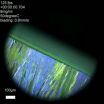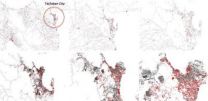(Press-News.org) Researchers at Griffith University's Eskitis Institute have developed a new technique for discovering natural compounds which could form the basis of novel therapeutic drugs.
The corresponding author, Professor Ronald Quinn AM said testing the new process on a marine sponge had delivered not only confirmation that the system is effective, but also a potential lead in the fight against Parkinson's disease.
"We have found a new screening method which allows us to identify novel molecules drawn from nature to test for biological activity," Professor Quinn said.
"As it happens, the first new compound we discovered through this process has demonstrated a response in Parkinson's disease cells."
Prestigious chemistry journal Angewandte Chemie has published the results in "NMR Fingerprints of the Drug-like Natural Product Space: Iotrochotazine A, a Chemical Probe to Study Parkinson's Disease". (DOI: 10.1002/anie.201402239)
The first author Dr Tanja Grkovic said the screening process involves nuclear magnetic resonance (NMR) spectroscopy; a highly sensitive instrument through which it is possible to see natural products weighing as little as 20 micrograms, which is less than a grain of salt.
"When you are searching for nature-derived molecules, the jackpot is finding something that nobody has ever seen before and rather than just a variation on a known theme," Dr Grkovic said.
"We began the project by selecting 20 marine sponge samples randomly from Griffith's Nature Bank facility and using the NMR technique trying to visualise all the small molecules which could meet the requirements for a potential new drug.
"The idea was to look at patterns of data and identify unusual or unique sets. We followed one such pattern and isolated a natural product with a novel skeleton which has turned out to be a molecule which was completely unknown previously."
Griffith's Nature Bank is a unique drug discovery resource based on natural products found in Australia, China and Papua New Guinea. It comprises more than 45,000 samples of plants and marine invertebrates, 200,000 semi-purified fractions, 3,250 pure compounds and over 600 naturally-occurring fragments.
This NMR screening process provides a new way of searching all those natural samples stored in Nature Bank and uncovering the potential biological activity of the compounds within them.
Deputy Director of the Eskitis Institute and co-author of the paper, Associate Professor George Mellick, is a specialist researcher in neurodegenerative diseases such as Parkinson's disease. He is delighted by the research prospects this new molecule may provide.
"What is very intriguing about this novel natural product is that, while we have found it has an effect on cells sourced from a Parkinson's patient, it showed a different biological activity on cells from healthy individuals," Associate Professor Mellick said.
"This provides us with a new tool to study the fundamental biology of Parkinson's and to get a better understanding of the cellular processes involved in the development of this disease.
But the Parkinson's response is just the start.
"This new research technique opens the door to unlimited opportunities, both in terms of chemistry and biology research at Eskitis, as we continue the search for new therapies against disease," Professor Quinn said.
INFORMATION: END
Breakthrough points to new drugs from nature
New screening technique opens the door to unlimited opportunities, both in terms of chemistry and biology research
2014-04-16
ELSE PRESS RELEASES FROM THIS DATE:
Global scientific team 'visualizes' a new crystallization process
2014-04-16
VIDEO:
This is a high speed video of the crystal ribbons forming as the solution is spread using a squeegee like technique.
Click here for more information.
Sometimes engineers invent something before they fully comprehend why it works. To understand the "why," they must often create new tools and techniques in a virtuous cycle that improves the original invention while also advancing basic scientific knowledge.
Such was the case about two years ago, when Stanford engineers ...
Researchers propose network-based evaluation tool to assess relief operations feasibility
2014-04-16
The United Nations Office for Disaster Risk Reduction reported that disasters have affected around 2.9 billion people worldwide from 2000-2012— killing more than a million, and damaging around 1.7 trillion US dollars in estimates. Moreover, natural disasters and their damages have been documented to occur with increasing intensity. Given the staggering numbers, effective disaster preparedness and relief response plans is compelling, especially considering the fact that natural disasters are usually unpredictable and damage cannot be avoided.
Implementing a speedy and ...
Medieval slave trade routes in Eastern Europe extended from Finland and the Baltic Countries to Asia
2014-04-16
The routes of slave trade in Eastern Europe in the medieval and pre-modern period extended all the way to the Caspian Sea and Central Asia. A recent study completed at the University of Eastern Finland suggests that persons captured during raids into areas which today constitute parts of Finland, the Russian Karelia and the Baltic Countries ended up being sold on these remote trade routes. There was a particular demand for blonde girls and boys who were seen as exotic luxury items, and it was financially beneficial to transport them to the far-away markets. The study by ...
Study provides new insight into how toddlers learn verbs
2014-04-16
Parents can help toddlers' language skills by showing them a variety of examples of different actions, according to new research from the University of Liverpool.
Previous research has shown that verbs pose particular difficulties to toddlers as they refer to actions rather than objects, and actions are often different each time a child sees them.
To find out more about this area of child language, University psychologists asked a group of toddlers to watch one of two short videos. They then examined whether watching a cartoon star repeat the same action, compared ...
Potential use of Google Glass in surgical settings
2014-04-16
Oxford, UK, April 15, 2014 – An article recently published in the International Journal of Surgery shows the potential applications for Google Glass in the surgical setting, particularly in relation to training.
Personal portable information technology is advancing at a breathtaking speed. Google has recently introduced Glass, a device that is worn like conventional glasses, but that combines a computerized central processing unit, touchpad, display screen, high-definition camera, microphone, bone-conduction transducer, and wireless connectivity.
The authors of the ...
Multiple births don't have to be an inevitable result of fertility treatments
2014-04-16
While fertility treatments have helped many people become parents, they commonly result in multiple births, increasing the risk of prematurity, and leading to lifelong complications. But this doesn't have to be the case, according to Yale School of Medicine researchers and their colleagues, who recommend sweeping changes to policy and clinical practice in a study published in the April issue of Fertility & Sterility.
Pasquale Patrizio, M.D., professor in the Department of Obstetrics, Gynecology & Reproductive Sciences at Yale School of Medicine, and his colleagues at ...
Ant colonies help evacuees in disaster zones
2014-04-16
An escape route mapping system based on the behavior of ant colonies could give evacuees a better chance of reaching safe harbor after a natural disaster or terrorist attack by building a map of showing the shortest routes to shelters and providing regular updates of current situations such as fires, blocked roads or other damage via the smart phones of emergency workers and those caught up in the disaster.
Koichi Asakura of Daido University in Nagoya and Toyohide Watanabe of the Nagoya Industrial Science Research Institute in Japan have carried out successful simulations ...
New Geosphere series: The St. Elias Erosion/Tectonics Project in Southern Alaska
2014-04-16
Boulder, Colo., USA – GEOSPHERE has added a new themed issue to its roster: "Neogene tectonics and climate-tectonic interactions in the southern Alaskan orogeny." Interest in Alaskan tectonics has varied over time, propelled mostly by geologic hazards. In 1964, the great Alaskan earthquake focused attention on Alaska and was a major factor in the establishment of the concept of subduction in the early days of plate tectonics.
In the 1980s, the northern Cordillera, including Alaska, was the subject of extensive study using the terrane analysis approach, which spawned ...
Diverse gene pool critical for tigers' survival, say Stanford scholars
2014-04-16
New research by Stanford scholars shows that increasing genetic diversity among the 3,000 or so tigers left on the planet is the key to their survival as a species.
Iconic symbols of power and beauty, wild tigers may roam only in stories someday soon. Their historical range has been reduced by more than 90 percent. But conservation plans that focus only on increasing numbers and preserving distinct subspecies ignore genetic diversity, according to the study. In fact, under that approach, the tiger could vanish entirely.
"Numbers don't tell the entire story," said study ...
UT Arlington physicist creates new nanoparticle for cancer therapy
2014-04-16
A University of Texas at Arlington physicist working to create a luminescent nanoparticle to use in security-related radiation detection may have instead happened upon an advance in photodynamic cancer therapy.
Wei Chen, professor of physics and co-director of UT Arlington's Center for Security Advances Via Applied Nanotechnology, was testing a copper-cysteamine complex created in his lab when he discovered unexplained decreases in its luminescence, or light emitting power, over a time-lapse exposure to X-rays. Looking further, he found that the nanoparticles, called ...
LAST 30 PRESS RELEASES:
First Editorial of 2026: Resisting AI slop
Joint ground- and space-based observations reveal Saturn-mass rogue planet
Inheritable genetic variant offers protection against blood cancer risk and progression
Pigs settled Pacific islands alongside early human voyagers
A Coral reef’s daily pulse reshapes microbes in surrounding waters
EAST Tokamak experiments exceed plasma density limit, offering new approach to fusion ignition
Groundbreaking discovery reveals Africa’s oldest cremation pyre and complex ritual practices
First breathing ‘lung-on-chip’ developed using genetically identical cells
How people moved pigs across the Pacific
Interaction of climate change and human activity and its impact on plant diversity in Qinghai-Tibet plateau
From addressing uncertainty to national strategy: an interpretation of Professor Lim Siong Guan’s views
Clinical trials on AI language model use in digestive healthcare
Scientists improve robotic visual–inertial trajectory localization accuracy using cross-modal interaction and selection techniques
Correlation between cancer cachexia and immune-related adverse events in HCC
Human adipose tissue: a new source for functional organoids
Metro lines double as freight highways during off-peak hours, Beijing study shows
Biomedical functions and applications of nanomaterials in tumor diagnosis and treatment: perspectives from ophthalmic oncology
3D imaging unveils how passivation improves perovskite solar cell performance
Enriching framework Al sites in 8-membered rings of Cu-SSZ-39 zeolite to enhance low-temperature ammonia selective catalytic reduction performance
AI-powered RNA drug development: a new frontier in therapeutics
Decoupling the HOR enhancement on PtRu: Dynamically matching interfacial water to reaction coordinates
Sulfur isn’t poisonous when it synergistically acts with phosphine in olefins hydroformylation
URI researchers uncover molecular mechanisms behind speciation in corals
Chitin based carbon aerogel offers a cleaner way to store thermal energy
Tracing hidden sources of nitrate pollution in rapidly changing rural urban landscapes
Viruses on plastic pollution may quietly accelerate the spread of antibiotic resistance
Three UH Rainbow Babies & Children’s faculty elected to prestigious American Pediatric Society
Tunnel resilience models unveiled to aid post-earthquake recovery
Satellite communication systems: the future of 5G/6G connectivity
Space computing power networks: a new frontier for satellite technologies
[Press-News.org] Breakthrough points to new drugs from natureNew screening technique opens the door to unlimited opportunities, both in terms of chemistry and biology research


